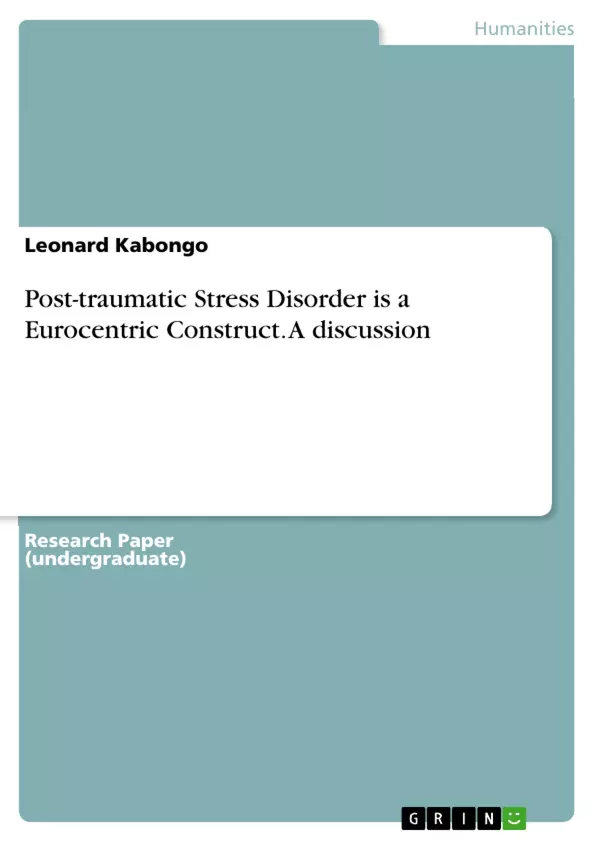According to the American Psychiatric Association (2013), Posttraumatic Stress Disorder (PTSD) is defined in the DSMV (Diagnostic and Statistical Manual for Mental Disorders Firth Edition) as a group of psychiatric related symptoms after exposure to actual or threatened death, serious injury, or sexual violence by direct experience, witnessing or distant learning of a traumatic event that occurred to a close person. These symptoms include distressing memories and dreams of the traumatic event, dissociative reactions and marked psychological reactions to internal and external cues that symbolize the event, avoidance of or efforts to avoid distressing memories, thoughts or feelings, negative alterations in cognitions like dissociative amnesia and feeling of detachment, angry outbursts, irritability behavior, recklessness, hypervigilance and sleep disturbance. The diagnosis of PTSD is established when the above mentioned symptoms persist for one month and exhibit clinical manifestations, significant distress of impairment in social and occupational functioning not associated with a substance abuse (alcohol or drug).
Introduced in the 1980 in the DSMIII after the Vietnam War, PTSD concept was however not new in the history of Medicine. It has evolved historically from the time of Homer and has been recognized and described for the past century. The holocaust and more recently the American World Trade Center attack has brought into the trauma theory with more publications been released. From its definition in the DSMV, PTSD is viewed as a result of an abrupt, singled traumatic event and its consequences on the human psyche resulting in pschychiatric symptoms as I mentioned above. From this angle, the definition of PTSD is non inclusive expressing an individualized, monoculture and unilateral historic considerations which is argued as a Euro-American culture-bound syndrome that does not apply traditional cultures. On the other hand, for other psychologists and psychiatrists the new concept of PTSD (as defined in the DSMV) is thought to have provided an operational definition applicable for many clinical situations, showed a link between physical pain and psychological event, recognized the extend of a traumatic exposure and more importantly fertilized
Inhaltsverzeichnis (Table of Contents)
- Introduction
- PTSD and Cross-cultural considerations
- Universal validity of PTSD
- Conclusion
Zielsetzung und Themenschwerpunkte (Objectives and Key Themes)
This text explores the cultural implications of Posttraumatic Stress Disorder (PTSD) by examining the validity of its definition and the appropriateness of its treatment in diverse cultural contexts. It challenges the Euro-American perspective on PTSD and its limitations in understanding the experience of trauma across different cultures. The text aims to highlight the influence of cultural beliefs, traditions, and healing practices on the manifestation and treatment of PTSD.
- The Cultural Construction of Trauma
- The Universal Validity of PTSD
- Cultural Influences on Healing and Treatment
- The Limitations of Western Trauma Theory
- Ethnocultural Considerations in PTSD Diagnosis and Treatment
Zusammenfassung der Kapitel (Chapter Summaries)
- Introduction: This chapter defines PTSD according to the DSMV, highlighting its historical evolution and the debate surrounding its universality. It introduces the cultural influences on trauma experience and healing, focusing on the limitations of the Euro-American perspective on PTSD.
- PTSD and Cross-cultural considerations: This chapter delves into the cultural variations in the experience and manifestation of PTSD. It explores the role of cultural beliefs, traditions, and healing practices in shaping the posttraumatic experience. This chapter also examines the critiques of Western approaches to PTSD, emphasizing the need for culturally sensitive interventions.
Schlüsselwörter (Keywords)
The text focuses on the concept of Posttraumatic Stress Disorder (PTSD), examining its cultural validity, the influence of ethnoculture on its diagnosis and treatment, and the limitations of Western trauma theory. The main keywords include PTSD, cross-cultural considerations, cultural beliefs, trauma, healing, ethnoculture, Western trauma theory, cultural sensitivity, and diverse cultural contexts.
- Citar trabajo
- Dr Leonard Kabongo (Autor), 2015, Post-traumatic Stress Disorder is a Eurocentric Construct. A discussion, Múnich, GRIN Verlag, https://www.grin.com/document/305673



